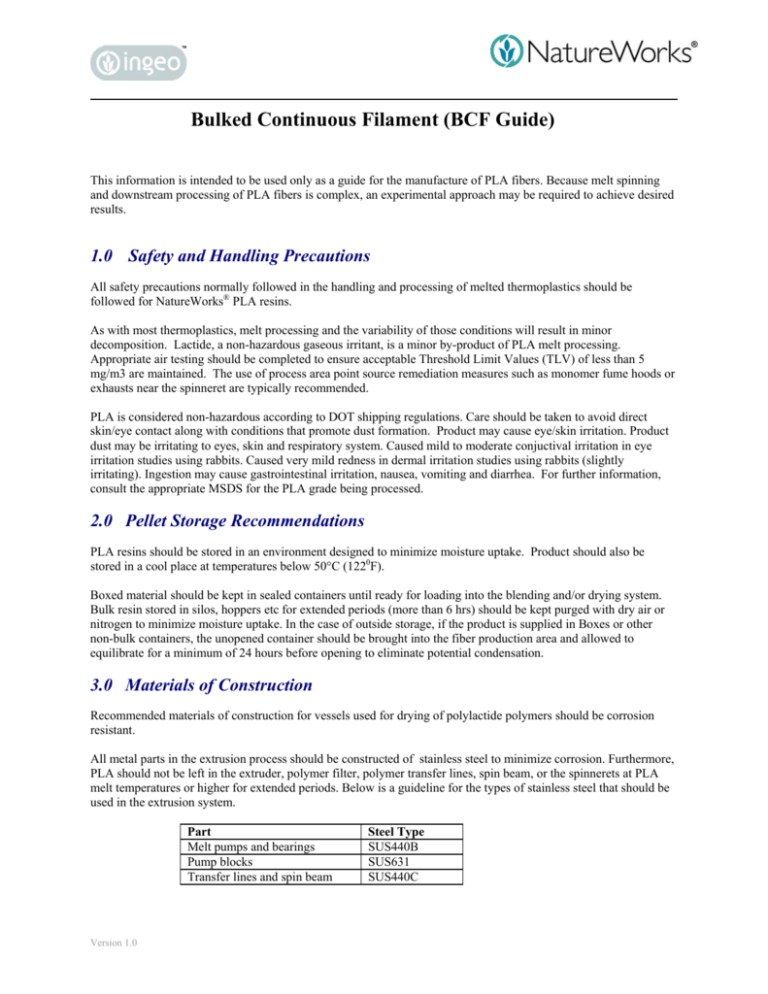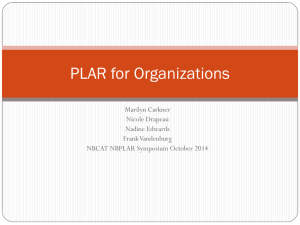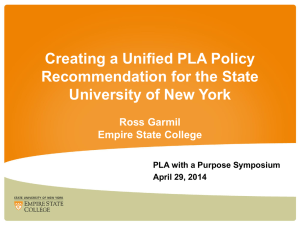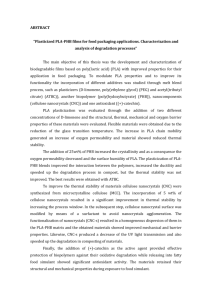Bulked Continuous Filament (BCF Guide)
advertisement

Bulked Continuous Filament (BCF Guide) This information is intended to be used only as a guide for the manufacture of PLA fibers. Because melt spinning and downstream processing of PLA fibers is complex, an experimental approach may be required to achieve desired results. 1.0 Safety and Handling Precautions All safety precautions normally followed in the handling and processing of melted thermoplastics should be followed for NatureWorks® PLA resins. As with most thermoplastics, melt processing and the variability of those conditions will result in minor decomposition. Lactide, a non-hazardous gaseous irritant, is a minor by-product of PLA melt processing. Appropriate air testing should be completed to ensure acceptable Threshold Limit Values (TLV) of less than 5 mg/m3 are maintained. The use of process area point source remediation measures such as monomer fume hoods or exhausts near the spinneret are typically recommended. PLA is considered non-hazardous according to DOT shipping regulations. Care should be taken to avoid direct skin/eye contact along with conditions that promote dust formation. Product may cause eye/skin irritation. Product dust may be irritating to eyes, skin and respiratory system. Caused mild to moderate conjuctival irritation in eye irritation studies using rabbits. Caused very mild redness in dermal irritation studies using rabbits (slightly irritating). Ingestion may cause gastrointestinal irritation, nausea, vomiting and diarrhea. For further information, consult the appropriate MSDS for the PLA grade being processed. 2.0 Pellet Storage Recommendations PLA resins should be stored in an environment designed to minimize moisture uptake. Product should also be stored in a cool place at temperatures below 50°C (1220F). Boxed material should be kept in sealed containers until ready for loading into the blending and/or drying system. Bulk resin stored in silos, hoppers etc for extended periods (more than 6 hrs) should be kept purged with dry air or nitrogen to minimize moisture uptake. In the case of outside storage, if the product is supplied in Boxes or other non-bulk containers, the unopened container should be brought into the fiber production area and allowed to equilibrate for a minimum of 24 hours before opening to eliminate potential condensation. 3.0 Materials of Construction Recommended materials of construction for vessels used for drying of polylactide polymers should be corrosion resistant. All metal parts in the extrusion process should be constructed of stainless steel to minimize corrosion. Furthermore, PLA should not be left in the extruder, polymer filter, polymer transfer lines, spin beam, or the spinnerets at PLA melt temperatures or higher for extended periods. Below is a guideline for the types of stainless steel that should be used in the extrusion system. Part Melt pumps and bearings Pump blocks Transfer lines and spin beam Version 1.0 Steel Type SUS440B SUS631 SUS440C 4.0 Line Preparation Prior to introducing PLA into any melt spinning system, the system should be properly purged to prevent any polymer contamination and spinning problems from occurring. The purging procedures below are recommended for optimal removal of other polymers. PLA Purging Procedure Following PP in your system (not degraded by cooling and re-heating system) At normal PLA operating temperatures, run PP(15- 40 MI) without spinneret in place. Purge for at least 3x average residence time without spinneret in place. Let system empty as well as possible. Transition to PLA and purge following the same guidelines as step 1. Insert a pre-heated spin pack and allow temperature to equilibrate. Purge with PLA and evaluate flow from capillaries. As long as flow is even from each capillary and there is no evidence of contamination, begin spinning. Purge all PLA from your extrusion system immediately after completing a production trial or run. Following PET, Nylon or HDPE in your system Purge with low MI (<1) PP at normal PET operating temperatures. Purge for at least 3x average residence time or until PP stream is clean PP without spinneret in place. Let system empty as well as possible. Change to normal PLA operating temperatures and run a high melt index PP (15-40 MI). Purge for at least 3x average residence time without spinneret in place. Let system empty as well as possible. Transition to PLA and purge following the same guidelines as steps 1 and 2. Insert a pre-heated spin pack and allow temperature to equilibrate. Purge with PLA and evaluate flow from capillaries. As long as flow is even from each capillary and there is no evidence of contamination, begin spinning. Purge all PLA from your extrusion system immediately after completing a production trial or run. Important Notes: It is critical that all drying and conveying/receiving systems be free of all PET/Nylon/PP or other contaminant and be vacuumed to ensure that there is no remaining polymer dust, before adding PLA. PET/Nylon will not melt at PLA operating temperatures and will block screens or cause potential damage to melt pumps, if this is the case. PLA and PP or PE are incompatible. PET can be mixed with PLA, but is a solid at PLA operating temperatures. For best results, PLA should be dried to less than 50 ppm H2O. Brand of PP used for purging is unimportant, as long as it does not thermally cross-link. When handling PLA pellets, the generation of small particles or fines is possible. Conveying pellets slower, such as at a velocity of 25 m/s, will generate fewer fines than at 30 m/s when conveying in dilute phase. Please note that with dilute phase conveying, enough velocity must be maintained to prevent the pellets from plugging the line. Internal and external testing did not show plugging problems at 25 m/s. Version 1.0 5.0 Drying PLA resin can be successfully dried using most standard drying systems. Recommended conditions are provided for standard desiccant based column dryers. For other drying system designs, additional information can be provided upon request. To prevent equipment corrosion, it is not recommended to dry or store hot PLA resin in carbon steel vessels (see Section 3.0). In-line drying is essential for PLA resins. A moisture content of less than (50 PPM) is recommended to prevent viscosity degradation. Material is supplied in foil-lined boxes dried to less than 400 PPM as measured by NatureWorks LLC internal method. The resin should not be exposed to atmospheric conditions after drying. Keep the package sealed until ready to use and promptly dry and reseal any unused material. The drying table below can be used to estimate the drying time needed for PLA, but actual moisture levels should be measured and monitored, to ensure adequate drying, while running. Air or nitrogen based desiccant drying systems can be used at the recommended temperatures. Typical desiccant drying system conditions follow: Typical Settings Drying Parameter Residence Time (hours) Air Temperature (oC) Air Dew Point (oC) Air Flow Rate (ft3/min/lb resin) Minimum 4 hrs 80 C / 176 F - 40 > 0.25 Minimum 2 hrs 100 C / 211 F - 40 > 0.25 Note 1: The drying times above are based on polymer coming from the foiled bags and at <400 ppm moisture. Actual drier performance may vary and chip moisture after drying should be measured. Note 2: Typical desiccant dryer regeneration temperatures exceed the melt point of PLA resins. To prevent issues with pellet bridging, sticking or melting, the drying system operation should be verified to ensure temperature control is adequate during operation as well as during regeneration cycles since valve leakage is common in many systems. 5.1 Extruder General Purpose Single-Screw extruder, 24 to 32:1 L/D with feed-throat cooling. A mixing tip is generally recommended along with static mixers in the product line to ensure temperature uniformity as well as optimum additive dispersion and melt polymer homogeneity. Extrusion Conditions Feed throat 25°C (77°F) Zone 1 200°C (392°F) Zone 2 220°C (428°F) Zone 3 230°C (446°F) Melt pump 230°C (446°F) Spin head 230°C (446°F) Note 1: Temperatures are only starting points and may need to be altered. Target PLA melt temperatures (after melt pump) should be in the range of 235±5°C (455±9°F). Version 1.0 Note 2: PLA resins should not be processed at temperatures above 250°C (482°F) due to excessive thermal degradation. 5.2 Additives Colorants can best be added by a masterbatch process into PLA. The carrier for the color needs to be PLA to insure there are no compatibility issues. NOTE: Prior to using a new additive NatureWorks® PLA should be notified and proper testing done to qualify the additive. 5.3 Heating Systems To allow for the required temperatures to be obtained in spinning, typically vapor heat transfer system medium changes are required unless a vacuum assisted system is available. Dowtherm™ / Therminol™ or a comparable vapor HTM which has an atmospheric boiling point of 200°C(3920 F) or less while remaining within specific system pressure design limits is generally recommended. For vacuum assisted systems, typically heat transfer medium changes are not required as long as the system vacuum can be operated at a level to provide vaporization and uniform heating at the suggested temperatures (230-240°C or 446-464°F). Operation of the HTM system at a temperature as close as possible to the actual melt temperature (235±5°C or 455±9°F) is recommended to provide an adiabatic spinning system. Similar reductions in spin pack preheating ovens should be made. Recommended settings are usually 250°C (482°F) to allow for some temperature loss during spin pack installation. 5.4 Pack Build/filtration PLA resin will typically be provided pre-filtered to a level of 20 microns. The following pack makeup is recommended: Screens – cascade configuration with appropriate support screens is recommended with finest filtration level of 50 microns or 325 mesh screen. Spinneret – A variety of cross-sections spin well for PLA. However, a delta or a modified delta is recommended for improved resilience. The following is a typical dimension for a modified delta spinneret. Leg width = .0128 inches Leg length = .0227 inches Capillary length = .079 inches. Spinnerets are designed to minimize pressure drop draw down and thus allowing for increased draw during spinning. 5.5 Quench Conditions The initial recommended setting of 0.15-.5 meters per second quench velocity with a stable quench air temperature in the range of 22-25°C is desired. Depending on actual yarn count, filament spacing and machine design, these conditions (velocity and temperature) will vary and should be adjusted within the recommended ranges to obtain acceptable quality yarn. The lower quench velocity typically works best. A monomer exhaust system, or fume hoods near the spinneret should be operated to provide exhaust velocities at intake port of ~0.50 meters per second. Version 1.0 5.6 Finish Application Spin finish has proven to be a vital part of producing good quality yarn from PLA. Improper finish will result in numerous fiber breaks and inconsistent drawing during the spinning process. The recommended spin finish for PLA BCF is PL859. The finish is supplied from Goulson Technologies. Contact NatureWorks LLC for more information. A kiss roll works well. Finish should be mixed to a 15-20% emulsion. The recommended level of finish on yarn is .5-1%. The optimum level is dependent on the amount needed for down stream processing. 5.7 Spinning/Drawing PLA is capable of being spun at a wide range of spinning speeds. The typical spinning speed for BCF is in the range of 1500-3000 meters per minute. It is important to note that with higher as-spun velocities lower draw ratios will be achievable during the drawing stage. Pre-heat godet: 80-120C (176-248F) is the optimum pre-draw temperature range and will need to be optimized for each line. The minimum number of wraps on the pre-heat godet is four. NOTE: Drawing at a higher temperature than noted above may cause fiber to develop the incorrect crystalline morphology. The result may cause the fiber to loose physical properties prematurely (i.e. tenacity, elongation). Also if overdrawn PLA will develop a crazing on the surface and appear dull. Draw ratios: Optimum draw ratio is a function of polymer molecular weight, as-spun velocity, quench velocity, quench temperature and capillary design. The normal range of draw ratios has been from. Typical draw ratios are as follows: 1) 1500 meters per minute = 3.8-4.2 draw ratio 2) 2000 meters per minute = 3.7-4.0 draw ratio 3) 2500 meters per minute = 3.2-4.0 draw ratio 5.8 Heat-setting It is critical to heat set PLA fiber under tension. This is typically done with a heated godet prior to the bulking jet. Without heat setting PLA will have a high degree of shrinkage A heat set godet temperature 100-130C is recommended for low shrink fiber (i.e. <10% boiling water shrinkage). A typical BCF spinning line like the one below requires > 5 wraps on the heat set godet to achieve adequate shrinkage. It is best to start at 100C and work up to the desired shrinkage. 5.9 Texturing/interlace Typical texturing jet temperatures for PLA are between 90-110C. The higher the jet temperature the higher the bulk of the yarn. The jet may need to be optimized to run PLA. For example: A bulking jet with a reverse taper (PP design) may plug during operation. A bulking jet with a straight profile works well. Note:_____temperature must be lower than the heat set temperature to minimize fiber strength loss. A jet with an input tension of 25-50 grams is recommended to ensure a sufficient amount of tension between the heat set roll and the texturing unit is achieved. Interlace can be achieve with standard off the shelf interlacing systems such as the ones supplied by Heberlein. The optimum method for interlacing is between two godets. This allows the yarn tension to be optimized for the best results. Interlace pressure will need to be optimized for the desired number of nodes per meter. Version 1.0 6.0 Recommendations For Optimizing The BCF Process The use of a small amount of TIO2 in the polymer improves processing. Drawing in water or steam increases fiber properties. Using a heated shroud just below the spin pack can be used to improve physical properties. Putting the draw rolls closer together (decreasing the draw zone) improves the physical properties. The use of steam in the texturing jet may increase the bulk level of the yarn. Self-bulking yarn can be produced by varying the quench rate and also by the use of bicomponent technology. Increase in heat set time increases tenacity. 6.1 Typical Spinning Line BCF Manufacturing Spin head Preheat rolls Optimum Temperature 80-110 C Heat set rolls Finish applicator Optimum Temperature 100-130C Texturing Cooling drum Interlace Two position auto change winder Version 1.0 Safety and Handling Considerations Material Safety Data (MSD) sheets for PLA polymers are available from NatureWoks LLC. MSD sheets are provided to help customers satisfy their own handling, safety, and disposal needs, and those that may be required by locally applicable health and safety regulations, such as OSHA (U.S.A.), MAK (Germany), or WHMIS (Canada). MSD sheets are updated regularly; therefore, please request and review the most current MSD sheets before handling or using any product. The following comments apply only to PLA polymers; additives and processing aids used in fabrication and other materials used in finishing steps have their own safe-use profile and must be investigated separately. Hazards and Handling Precautions PLA polymers have a very low degree of toxicity and, under normal conditions of use, should pose no unusual problems from incidental ingestion, or eye and skin contact. However, caution is advised when handling, storing, using, or disposing of these resins, and good housekeeping and controlling of dusts are necessary for safe handling of product. Workers should be protected from the possibility of contact with molten resin during fabrication. Handling and fabrication of resins can result in the generation of vapors and dusts that may cause irritation to eyes and the upper respiratory tract. In dusty atmospheres, use an approved dust respirator. Pellets or beads may present a slipping hazard. Good general ventilation of the polymer processing area is recommended. At temperatures exceeding the polymer melt temperature (typically 170ºC), polymer can release fumes, which may contain fragments of the polymer, creating a potential to irritate eyes and mucous membranes. Good general ventilation should be sufficient for most conditions. Local exhaust ventilation is recom-mended for melt operations. Use safety glasses if there is a potential for exposure to particles which could cause mechanical injury to the eye. If vapor exposure causes eye discomfort, use a full-face respirator. No other precautions other than clean, body-covering clothing should be needed for handling PLA polymers. Use gloves with insulation for thermal protection when exposure to the melt is localized. Combustibility PLA polymers will burn. Clear to white smoke is produced when product burns. Toxic fumes are released under conditions of incomplete combustion. Do not permit dust to accumulate. Dust layers can be ignited by spontaneous combustion or other ignition sources. When suspended in air, dust can pose an explosion hazard. Firefighters should wear positive-pressure, selfcontained breathing apparatuses and full protective equipment. Water or water fog is the preferred extinguishing medium. Foam, alcoholresistant foam, carbon dioxide or dry chemicals may also be used. Soak thoroughly with water to cool and prevent re-ignition. Disposal DO NOT DUMP INTO ANY SEWERS, ON THE GROUND, OR INTO ANY BODY OF WATER. For unused or uncontaminated material, the preferred options include recycling into the process or sending to an industrial composting facility, if available; otherwise, send to an incinerator or other thermal destruction device. For used or contaminated material, the disposal options remain the same, although additional evaluation is required. (For example, in the U.S.A., see 40 CFR, Part 261, “Identification and Listing of Hazardous Waste.”) All disposal methods must be in compliance with Federal, State/Provincial, and local laws and regulations. Environmental Concerns Generally speaking, lost pellets are not a problem in the environment except under unusual circumstances when they enter the marine environment. They are benign in terms of their physical environmental impact, but if ingested by waterfowl or aquatic life, they may mechanically cause adverse effects. Spills should be minimized, and they should be cleaned up when they happen. Plastics should not be discarded into the ocean or any other body of water. Product Stewardship NatureWorks LLC has a fundamental duty to all those that make and use our products, and for the environment in which we live. This duty is the basis for our Product Stewardship philosophy, by which we assess the health and environmental information on our products and their intended use, then take appropriate steps to protect the environment and the health of our employees and the public. Customer Notice NatureWorks LLC encourages its customers and potential users of its products to review their applications for such products from the standpoint of human health and environmental quality. To help ensure our products are not used in ways for which they were not intended or tested, our personnel will assist customers in dealing with ecological and product safety considerations. Your sales representative can arrange the proper contacts. NatureWorks LLC literature, including Material Safety Data sheets, should be consulted prior to the use of the company’s products. These are available from your NatureWorks LLC representative. NOTICE: No freedom from any patent owned by NatureWorks LLC or others is to be inferred. Because use conditions and applicable laws may differ from one location to another and may change with time, Customer is responsible for determining whether products and the information in this document are appropriate for Customer’s use and for ensuring that Customer’s workplace and disposal practices are in compliance with applicable laws and other governmental enactments. NatureWorks LLC assumes no obligation or liability for the information in this document. NO WARRANTIES ARE GIVEN; ALL IMPLIED WARRANTIES OF MERCHANTABILITY OR FITNESS FOR A PARTICULAR USE ARE EXPRESSLY EXCLUDED. NOTICE REGARDING PROHIBITED USE RESTRICTIONS: NatureWorks LLC does not recommend any of its products, including samples, for use as: Components of, or packaging for, tobacco products; Components of products where the end product is intended for human or animal consumption; In any application that is intended for any internal contact with human body fluids or body tissues; As a critical component in any medical device that supports or sustains human life; In any product that is designed specifically for ingestion or internal use by pregnant women; and in any application designed specifically to promote or interfere with human reproduction. NatureWorks and the NatureWorks logo are trademarks of NatureWorks LLC Copyright © 2005 NatureWorks LLC Version 1.0




